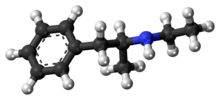Etilamfetamine
 | |
 | |
| Clinical data | |
|---|---|
| Routes of administration | Oral, sublingual, insufflated, inhaled (vaporized), intravenous, rectal |
| ATC code | |
| Legal status | |
| Legal status |
|
| Pharmacokinetic data | |
| Metabolism | Hepatic |
| Excretion | Renal |
| Identifiers | |
| |
| CAS Number | |
| PubChem CID | |
| ChemSpider | |
| KEGG | |
| ChEMBL | |
| ECHA InfoCard |
100.230.711 |
| Chemical and physical data | |
| Formula | C11H17N |
| Molar mass | 163.259 g/mol |
| 3D model (JSmol) | |
| |
| |
| (verify) | |
Etilamfetamine (Apetinil, Adiparthrol), also known as N-ethylamphetamine, is a stimulant drug of the phenethylamine and amphetamine chemical classes. It was invented in the early 20th century and was subsequently used as an anorectic or appetite suppressant in the 1950s,[1] but was not as commonly used as other amphetamines such as amphetamine, methamphetamine, and benzphetamine, and was largely discontinued once newer drugs such as phenmetrazine were introduced.
Chemistry
The molecular structure of ethylamphetamine is analogous to amphetamine's.[Note 1] It is a substituted amphetamine, with an ethyl group on the amphetamine backbone.[Note 2][Note 3]
Recreational use
Ethylamphetamine can be used as a recreational drug and, while its prevalence is less than amphetamine's, it is still encountered as a substance taken for recreational purposes.
Ethylamphetamine produces effects similar to amphetamine and methamphetamine. Its potency is less than amphetamine or methamphetamine. At equipotent dosage ethylamphetamine is subjectively less euphorigenic.[Note 4][Note 5]
See also
References
Notes
- ↑ Amphetamine is a substituted phenethylamine with a methyl group at RA position.
- ↑ The ethyl group of ethylamphetamine is at RN position, hence the name N-ethylamphetamine.
- ↑ Ethylamphetamine is structurally similar to N-methylamphetamine (methamphetamine), the ethyl group being replaced in methamphetamine with a methyl group.
- ↑ Ethylamphetamine's lower potency may make its risk of causing abuse, dependence and/or addiction marginally less compared to amphetamine.
- ↑ A cohort of Australian users in the 1990s found single 40 mg doses of commercially manufactured racemic ethylamphetamine hydrochloride substantially less effective recreationally than 40 mg doses of either racemic amphetamine sulphate, d-methylamphetamine hydrochloride or racemic fenethylline hydrochloride.